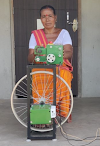This week, certain schools and workplaces in Kerala, a state in southern India, were closed as authorities rushed to stop the spread of the deadly Nipah virus after it claimed the lives of two individuals in its fourth outbreak since 2018.
What is known about the virus is as follows:
WHERE DID THE VIRUS COME FROM?
When pig farmers in Malaysia and Singapore began to become ill, the Nipah virus was first discovered.
Through direct contact with the body fluids of infected bats and pigs, it can infect people. There have been some reported cases of transmission among humans.
Nipah is thought to have been present in flying foxes for a very long time, and scientists worry that bats will eventually produce a modified form that is very contagious.
HOW IS THE INFECTION TREATED?
The illness has a death rate of over 70% and no vaccinations exist to treat or prevent it. The standard course of therapy is to offer supportive care.
According to the World Health Organization (WHO), first signs of infection include fever, respiratory discomfort, headaches, and vomiting. In extreme situations, encephalitis and seizures can also happen and result in coma.
The virus is on the WHO's list of diseases having pandemic potential for study and development.
WHERE WERE THE EARLIER OUTBREAKS?
More than 100 persons were murdered and close to 300 were infected during the 1998 outbreak in Malaysia and Singapore. Since then, it has traveled thousands of kilometers and claimed the lives of between 72% and 86% of people who contracted it.
According to WHO data, around 600 human illnesses with the Nipah virus were documented between 1998 and 2015.
Of the 91 affected, 62 died in an outbreak in 2001 in India and two more in Bangladesh.
With more outbreaks in 2019 and 2021, a Kerala epidemic in 2018 took 21 lives.
A Reuters research in May revealed that areas of Kerala are among the ones that are most vulnerable to bat virus epidemics internationally.









0 Comments